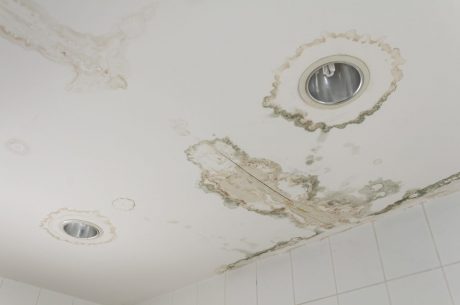Table of Contents

A ceiling leak is never a good sign. Whether it’s a slow drip or a sudden burst, water coming through your ceiling can lead to structural damage, mold growth, and expensive repairs if not addressed quickly. Acting fast can save your home from severe water damage.
So, what should you do when you spot a leak? Let’s break it down step by step.
1. Identify the Source of the Ceiling Leak
Before you do anything else, try to locate where the water is coming from. A leak can originate from several sources, including:
- Roof leaks: Damaged shingles, clogged gutters, or a compromised flashing can let water seep into your attic and down to your ceiling.
- Plumbing leaks: Burst pipes or faulty plumbing in the floor above can cause water to drip down.
- HVAC system leaks: An overflowing AC drain pan or a clogged condensate line can result in a ceiling leak.
If the leak is persistent, shut off the main water supply to stop further damage.
2. Contain the Water and Minimize Damage
Once you notice a ceiling leak, your priority should be limiting the damage. Here’s how:
- Place a bucket or container under the leak to catch the dripping water.
- Use towels or old rags to soak up excess water and prevent puddles.
- Poke a small hole in the ceiling (if water is bulging) to relieve pressure and prevent a bigger collapse.
These quick steps can help reduce the spread of water damage while you find a permanent solution.
3. Move Furniture and Valuables Away
If the ceiling leak is near furniture, electronics, or important documents, move them immediately. Water damage can ruin upholstery, cause electrical hazards, and destroy sentimental items.
4. Dry the Affected Area
After containing the ceiling leak, drying out the area is crucial to prevent mold. Here’s what to do:
- Open windows and doors for ventilation.
- Use fans and dehumidifiers to speed up drying.
- Wipe down wet surfaces to remove excess moisture.
If the leak has soaked into drywall or insulation, professional drying might be necessary.
5. Check for Ceiling and Structural Damage
A ceiling leak can weaken the structure of your home. Inspect for:
🔹 Water stains – Yellowish or brownish marks on the ceiling.
🔹 Sagging or bubbling paint – A sign of trapped moisture.
🔹 Cracks or holes – Water can weaken the drywall, making it brittle.
If the ceiling is severely damaged, it may require repairs or even a full replacement.
6. Call a Professional Water Damage Restoration Company
Even if the leak seems minor, it’s best to call experts. DIY fixes often overlook hidden moisture, leading to mold and long-term structural damage.
A professional restoration company like PuroClean of Coral Gables can:
- Detect hidden water damage using advanced moisture detection tools.
- Thoroughly dry and restore affected areas.
- Prevent mold growth with expert treatment solutions.
- Repair damaged ceilings, walls, and insulation.
Our team responds 24/7 to water damage emergencies, ensuring your home is safe and dry as quickly as possible.
7. Prevent Future Ceiling Leaks
Once you’ve fixed the ceiling leak, take proactive steps to prevent another one:
- Inspect your roof regularly. Look for missing shingles and repair weak spots.
- Clean gutters and downspouts. Clogged gutters can cause water overflow, leading to leaks.
- Check for plumbing leaks. Inspect pipes in the attic or between floors for signs of wear.
- Maintain your HVAC system. Ensure your AC’s drain lines are clear and functioning properly.
Regular home maintenance can help you avoid the stress and cost of unexpected ceiling leaks.
FAQs About Ceiling Leaks
1. How do I know if my ceiling leak is from plumbing or the roof?
If the leak occurs only when it rains, it’s likely a roof issue. If it happens consistently or worsens when using water, plumbing is the probable cause.
2. Should I pop a water bubble in my ceiling?
Yes, but carefully! Poking a hole in a bulging ceiling helps drain trapped water, preventing a larger collapse. Use a small screwdriver and have a bucket ready to catch the water.
3. Can a ceiling leak cause mold?
Absolutely. Mold can start growing within 24-48 hours of water exposure, making quick drying and restoration essential.
4. How much does ceiling leak repair cost?
Costs vary depending on the extent of damage, but water damage restoration can range from a few hundred to several thousand dollars. Getting professional help early can save money in the long run.
5. Will my homeowner’s insurance cover a ceiling leak?
Insurance often covers sudden and accidental leaks, such as burst pipes, but may not cover gradual damage from neglect. Check your policy for details.
Don’t Let a Ceiling Leak Turn into a Disaster – Call PuroClean of Coral Gables Today!

A ceiling leak can quickly spiral into costly damage if not handled properly. Whether it’s a plumbing issue, roof problem, or HVAC malfunction, PuroClean of Coral Gables is here to help.
We specialize in water damage restoration, mold removal, and ceiling repair, ensuring your home is safe, dry, and fully restored. Call us now (305) 894-4343 for emergency water damage services!


 PuroClean of Coral Gables
PuroClean of Coral Gables